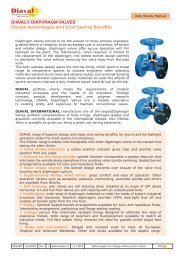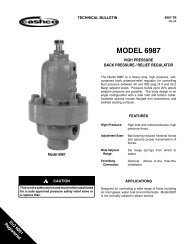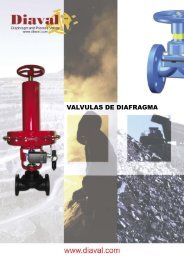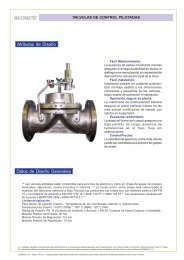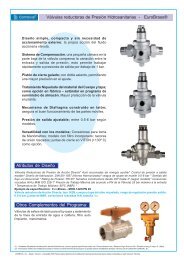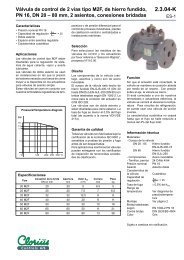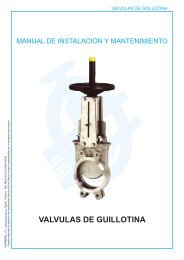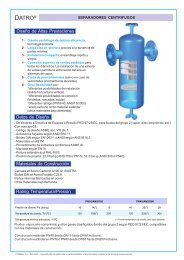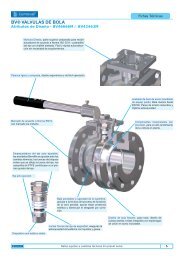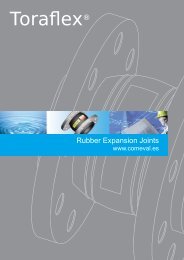Untitled - COMEVAL
Untitled - COMEVAL
Untitled - COMEVAL
You also want an ePaper? Increase the reach of your titles
YUMPU automatically turns print PDFs into web optimized ePapers that Google loves.
Unival® BUTTERFLY VALVES<br />
General Design Considerations<br />
Data Sheets Manual<br />
A butterfl y valve is a type of fl ow control device, typically used to regulate a<br />
fl uid fl owing through a section of pipe. A fl at circular plate (disc) is positioned<br />
in the centre of the pipe. The plate has a rod (shaft) through it connected<br />
to an actuator on the outside of the valve. Rotating the actuator turns<br />
the plate either parallel or perpendicular to the fl ow. Unlike a ball valve, the<br />
plate is always present within the fl ow, therefore a pressure drop is always<br />
induced in the fl ow regardless of valve position.<br />
A butterfl y valve is from a family of valves called quarter turn valves. The<br />
“butterfl y” is a metal disc mounted on a rod. When the valve is closed, the<br />
disc is turned so that it completely blocks off the passageway. When the<br />
valve is fully open, the disc is rotated a quarter turn so that it allows unrestricted<br />
passage. The valve may also be opened incrementally to regulate<br />
fl ow thanks to the gradual interlocking notch.<br />
Butterfl y valves are of simple design, of light weight and volume and very<br />
effective on isolating lines for its quick and safe operation. Most of butterfly<br />
valves design are fl angeless for installation between counter fl anges what<br />
saves space, costs and maintenance.<br />
There are two kind of fl angeless butterfl y valves:<br />
Wafer Style Butterfl y Valves: Wafer style is the more common one and is<br />
lest expensive one. The wafer style butterfl y valve is just about the standard.<br />
It is so common that no one even bothers to use the word “wafer”<br />
when ordering a butterfl y valve. They take it for granted that if they order<br />
a butterfl y valve, they will get a wafer style one. Wafer butterfl y valves are<br />
installed between two fl anges using bolts or studs and nuts. This type of<br />
installation, of course, makes it impossible to disconnect just one side of<br />
the piping system from the valve. That is where the lug style valve comes<br />
in.<br />
Lug Style Butterfl y Valves: Lug style valves are provided with tapered holes<br />
to fi x threaded bolts in. This allows them to be installed into a system using<br />
two sets of bolts and no nuts. The valve is installed between two flanges<br />
using a separate set of bolts for each fl ange. This set-up permits either side<br />
of the piping system to be disconnected without distributing the other side.<br />
Lug Style Butterfl y Valves are used in dead end service and generally have<br />
a reduced pressure rating.<br />
Valves can also be of dual fl anged design; provided with integral flanges<br />
that are ready to be installed between fl anges of the same standard. These<br />
are more bulky valves and usually required for large sizes and other styles<br />
of performance by the position of the shaft. (see next paragraph).<br />
Other kind of valves by its nature of shaft design are as follows:<br />
Concentric Design: This is the most common and simple design. The valve<br />
shaft is concentric to the disc. It is normally a resilient seated valve. Rotating<br />
the handle turns the plate either parallel or perpendicular to the flow of<br />
water, shutting off the fl ow<br />
Double Centric Design: This design features a slight offset in the way the<br />
disc is positioned, which increases the valve’s sealing ability and decreases<br />
its tendency to wear. It is normally used for throttling functions, larger sizes<br />
and / or metal seated valves.<br />
Triple Offset Design: This design is the one offering a highest degree of<br />
performance. The shaft is totally off set from the central axis thus increasing<br />
the ability of the valve disc to close tightly at even high pressure. These<br />
valves are usually metal seated thus being used for high temperature too.<br />
These valves are usually operated by worm gear to achieve a slow closing.<br />
Data subject to change without prior notice<br />
10



